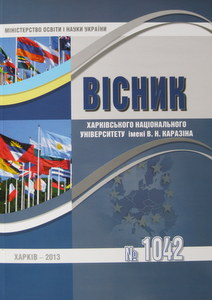Preliminary compilation of initial data for structural convergence detection of posttransformation and German economies
Keywords:
structural convergence, input-output table,
Abstract
The correspondence of branches classifications in Germany and Ukraine is established. The comparable input-output table for intermediate consumption is completedDownloads
Download data is not yet available.
References
Cornia, G.A. (2010). Transition, Structural Divergence, and Performance: Eastern Europe and the former Soviet Union over 2000-2007, UNU-WIDER Working Paper, WP2010/32, 2010, 20 p.
Crespo, N.; Fontoura, M.P. Integration of CEECs into EU Markets: Structural Change and Convergence, Journal of Common Market Studies, Vol. 45, September 2007, No. 3, pp. 611-632.
Percoco M., Dall’erba S. and Hewings G.J.D. Structural Convergence of the National Economies of Europe, in: Policy Analysis of Transport Networks, Ashgate, Aldershot Publishing, pp. 286-307.
Crespo, N.; Fontoura, M.P. Integration of CEECs into EU Markets: Structural Change and Convergence, Journal of Common Market Studies, Vol. 45, September 2007, No. 3, pp. 611-632.
Percoco M., Dall’erba S. and Hewings G.J.D. Structural Convergence of the National Economies of Europe, in: Policy Analysis of Transport Networks, Ashgate, Aldershot Publishing, pp. 286-307.
Cited
How to Cite
Arkhiyerieyev, S. (1). Preliminary compilation of initial data for structural convergence detection of posttransformation and German economies. The Journal of V. N. Karazin Kharkiv National University. Series: International Relations. Economics. Country Studies. Tourism, (1042), 70-76. Retrieved from https://periodicals.karazin.ua/irtb/article/view/6157
Section
Economy
Authors who publish with this journal agree to the following terms:
- Authors retain copyright and grant the journal right of first publication of this work under the terms of a license Creative Commons Attribution License 4.0 International (CC BY 4.0).
- Authors are able to enter into separate, additional contractual arrangements for the non-exclusive distribution of the journal's published version of the work (e.g., post it to an institutional repository or publish it in a book), with an acknowledgement of its initial publication in this journal.
- Authors are permitted and encouraged to post their work online (e.g., in institutional repositories or on their website) prior to and during the submission process, as it can lead to productive exchanges, as well as earlier and greater citation of published work.




